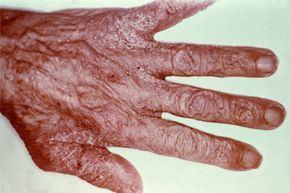Scabies Mite
A scabies mite is round, flat miniscule arthropod around 0.02 inches (0.4 millimeters) long (source: American Academy of Dermatology]. It looks a little bit like a turtle and has spines on its body. Scabies mites cause an infection known as scabies or mange in humans, dogs and cats, as well as other animals like horses, goats and sheep. The mites feed on skin cells and burrow irregular tracks just under the skin to feed and lay eggs. Their bites look like acne bumps. Both their presence and the burrowing cause the skin to react, creating intense itching. This leaves a person who has them with a scaly, flaking rash and thickened skin.
Typically the burrows start at the hands or feet, but they can spread quickly. A female scabies mite lays a few eggs a day, which hatch within the skin into larvae. The larvae also burrow and grow quickly into nymphs, then into adult mites, which mate. Adult mites can live for a few months, and the entire life cycle can essentially take place under the skin. Scabies mites are spread through contact with an infected person or animal as well as clothes, furniture and towels.
Advertisement
Because they're so tiny, it can be difficult to spot a single mite. The infection is usually diagnosed by the tracks left by the burrows, but scratching can also hide the tracks. To make them appear, you can rub the itchy area with ink and then wipe it with alcohol -- the tracks will appear. Doctors also diagnose scabies by looking at skin scrapings under a microscope. Animals with mange will often scratch themselves to the point of losing fur and getting open sores.
While the mites themselves don't spread disease, intense itching can lead to severe skin infections if left untreated. People with compromised immunity and the elderly can get a particularly painful and itchy type called crusted scabies. Treatment includes rubbing on an insecticide like permethrin or taking ivermectin, an oral antiparasitic. As with other skin parasites, treating the environment is essential -- everything should be washed in hot water and disinfected to prevent a re-infestation.
Not all fleas are created equal. In the next section, we'll look a type of flea called the chigoe.
